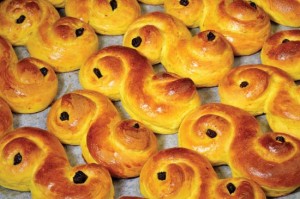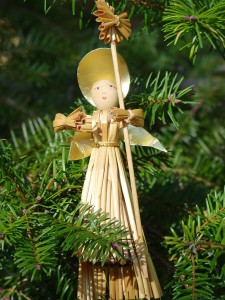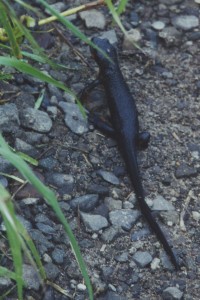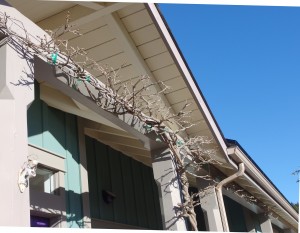Archive for the ‘seasons’ Category
A Swedish Christmas in London
Last week we went to a Swedish party – the St. Lucia festival, I wrote to my parents from England in mid-December 1962. The background of it seems somewhat confused – the story of a saint mixed up with old pagan mid-winter rites.
My confused reaction to this experience opened me to the concept of cultural adaptation: the way stories and beliefs from one tradition are assimilated into another. Growing up as a Christian in New Zealand, where the seasons are the opposite of the Northern Hemisphere, I was aware of an odd disconnect in the trappings of our festivals, but as yet did not fully comprehend why this should be.

Saffron bread (lussekatter), traditionally served on St. Lucia’s Day. Image from Encyclopedia Britannica.
The event was also a fun field trip for our group of Swedish language students at the College of Further Education in Slough, west of London. Tony and I had become enamored of all things Scandinavian, and hoped to go there one day. Our teacher, Ingrid, the daughter of a diplomat based in London, was eager to introduce us to London’s Swedish community. I tried to summarize her explanation of the festival in my letter, which continues:
The cattle were slaughtered about Dec. 13 for Christmas, and the women used to come out early in the morning with the men’s breakfast. It developed into a ceremony in which a young girl, attended by maidens and young boys, & wearing a head-dress of candles on her head, goes early in the morning to the homes of people in the district bringing hot coffee. Apparently in Stockholm anyway it has developed into a sort of beauty contest, but in London the Swedes are more Swedish than at home & we saw a more genuine procession of children (the little boys looking very self-conscious) singing charming old Swedish carols, & all carrying candles in the darkened room. Very effective & beautiful. The evening finished with coffee & Swedish cakes & pastries at candle-lit tables.
I later learned that before the Christian west adopted the Gregorian calendar in the late 1500s, St. Lucia’s Day fell on the winter solstice, and that it originally honored a goddess who brings the light in the dark Swedish winters. Traces of this solstice celebration linger in the words of the carols sung by the children.
The event we attended at the Swedish church in London also included a crafts fair, which I wrote about for my New Zealand newspaper. Here is the text:
SWEDISH CHRISTMAS DECORATIONS

The straw angel we bought at the church fair. Battered but loved, she still graces the top of our tree.
Our Christmas tree will be decorated with a Swedish angel this year. She is made out of barley straw, pale shining gold pieces neatly tied together. In the early days in Sweden, when the floors of homes were covered with straw to keep out the bitter cold, Christmas guests used to play with the shining straws, plaiting and twisting them into quaint figures. Now Swedish houses are centrally heated, but the custom has persisted, and wherever in the world Swedish people live, at Christmas their homes are always decorated with the golden figures and wreaths.
The Swedish community in London recently held their annual church fair, and out came the traditional Christmas gifts and decorations. As well as the charming angels, there were straw animals, goats and horses and dogs, and handsome plaited wreaths for hanging at the door. Other figures were turned or carved out of wood, and brightly painted. Particularly impressive were ranks of glowing red wooden horses in varying sizes, each painted with gaily decorated harness. Very thin pieces of wood were carved into the tails and wings of formalized birds. By contrast with the tinsel and glitter of English decorations, these traditional designs have a striking simplicity of line and a quaint charm that is refreshing and timeless.
Maureen is exploring an old black filing cabinet that contains 55 years of her papers and memorabilia.
I am thankful
I am thankful today for my new refrigerator. Our old one died a few weeks ago. Its replacement, a New Zealand-made Fisher & Paykel, was delayed by labor problems at the Los Angeles docks and eventually had to be unloaded in Vancouver and trucked down to Mendocino. Meanwhile Canclini’s, our local appliance dealer, gave us a smallish loaner, which has been parked out in the garage. We have gotten used to traipsing back and forth carrying milk or butter, and had set up ice chests on the back porch in preparation for an overflow of drinks and produce to feed our visiting family and friends during the Thanksgiving holiday.
It would be inconvenient, but we would cope. We’ve survived worse holiday crises. There was that time thirty-five years ago when we were remodeling an old house in Palo Alto. The kitchen walls were stripped down to the studs. Crates of new kitchen cabinets filled the living room, blocking access to the fireplace. I noted in my journal: At least I did warn [our friend] Judi that we might be picnicking amongst the mess. … [Our teenage sons] moved the kitchen cabinets today so that the sitting room & fireplace are usable again. Until the gas lines are reorganized, we have no heat, and the weather is getting colder, so it was important to be able to have a fire in the fireplace. We have plenty of firewood at least. On 11-30-1979 I noted that we had a delightful ‘old-fashioned’ Thanksgiving with Judi and her son Mark, who had been friends with our sons since they were little boys.
Thanksgiving a year later, the second floor completely rebuilt, we were waiting for the new roof to be completed and keeping a wary eye on the weather.
Journal 11-24-1980: The disaster finally happened over the weekend – eight weeks good luck couldn’t last. It rained Friday evening. Trusting in the plywood sheathing, we didn’t cover the floor with plastic all that thoroughly – a mistake. Throughout the night new drips opened up in the ceiling, mainly in the places where old plaster joined with new or at best was sagging or cracked. Buckets and towels all over the floor. We had to move out our bed because of a drip above us, which turned into a downpour slightly further along the crack about 3:00 am. David’s room also, where old gable met new roof, had a line of drips. Nasty watermark on the ceiling (most of which we were going to redo anyway). No permanent damage to floor. Spent all Sat. cleaning up in preparation for Thanksgiving, which I suspect is going to be as improvised as it was last year, though in different ways. Kitchen is finished, though with temporary lighting (as is all of ground floor). Can’t use the fireplace – need extension flue, which is still being built. Will have to decorate at eye level, prevent people’s eyes from moving upward, because of water marks on ceiling and upper walls. Stairwell still a mess of lath and ladders.
We survived that Thanksgiving holiday too. But this year we had a last-minute rescue. The kind men from Canclini’s brought us the new fridge on Wednesday morning and also left us the loaner until after the weekend, just in case we needed extra space. The turkey sits there now. In a little while, I’ll head out to the garage one more time and bring it in to the oven.
Thank you, Canclini TV & Appliances, and Happy Thanksgiving everyone.
Encounters with Newts
Now that our rains have finally started, the newts have come out of hiding. Last week I spent a couple of days at Green Gulch Farm, a Zen Buddhist retreat center and organic vegetable farm near San Francisco. California Newts were all over the paths. Their brown skin smooth, their underbellies a brilliant golden yellow, they were marching to the streams where they breed.
This morning we had to step around another California Newt on a path at the Mendocino Coast Botanical Gardens, a little one in its rough-skinned terrestrial phase. It was reluctant to move, since it was busy consuming a large earthworm; the last half-inch of the worm still hung from its mouth.
These encounters reminded me of visiting Montgomery Woods some years ago, when their close relatives the Red-bellied Newts were everywhere. I became fascinated with the story of their breeding migrations and wrote this poem, which was published in my 2007 chapbook, Quickening.
Red-Bellied Newt (Taricha rivularis)
What stirs, with the rain, that urge to return?
Some years she ignores the tingle in her nose,
the scent of that particular section of stream
where under a stone she hatched into a nymph,
then played for a year in the rippling water
before crawling transformed up the bank.
Summers she hides. Home is a secret hollow
under gnarled redwood roots in the ancient grove.
Some winters too. But once in a while, when the rains begin,
she emerges to make the journey to her breeding place.
Purposeful, she crawls, the red of her feet and belly
bright against the redwood duff,
navigating by smell to the rocky stream a mile away,
not home exactly, but the place she came from,
that pulls her back as it pulled her mother back.
Here she will mate, immersed in the water that gave her life,
deposit the fruits of her procreation under a stone,
then wander off to find good forage for the summer.
For thousands of years, as the giants grew overhead,
her kind have made this journey, secure in their faith
that the stream will still flow clear and fast over rocks.
They raise a question: what pulls us humans,
and to what deep places, and what is it we deposit,
like fertile newt eggs on the undersides of stones?
Pruning the Wisteria
I spent the morning pruning the wisteria vine that grows along our front porch. Up and down the tallest stepladder, leaning over the porch beam to reach the longest stems, I snipped and thinned. Each time I do this task, I remember with gratitude the workshop I attended years ago at the Elizabeth F. Gamble Garden in Palo Alto. “Be ruthless if you want flowers,” the instructor said. Ruthless I am. Otherwise the new growth pushes between the porch beam and ceiling, wraps itself round the lamp above the front door and seeks to enter the house itself.
Wisteria is not for the faint of heart. In May, as soon as the magnificent double purple flowers have bloomed and dropped, the new stems start growing. If left their own devices, they can reach ten feet in a year. As soon as they threaten to strangle visitors at the front door, I whack back as many as I can reach with my pole pruner. I may have to do this several times during the summer. In fall I haul out the big stepladder and take back all the foliage to somewhere near its supporting wire. However, in our mild coastal climate, the leaves don’t drop until well into the winter. It’s only then that I can see the structure I have trained over the years and can scrutinize each branch that sprouts from the main stem, looking for crossed twigs, dead wood, and stems facing back toward the house.
It’s a strenuous task. But when it is done, the prunings composted and the porch swept, there’s such a sense of satisfaction in looking up at the vine and seeing the shape of it against the house.
Transience
The print that hangs on my study wall is old now, as I am. When I look at it I remember seeing the original painting, Georges Rouault’s “The Old King,” in London in the early 1960s. It was on loan from the Carnegie Museum of Art, part of some big exhibition. The Tate or the National Gallery, I don’t remember which. A crowd of viewers. The friends I was with moved on to other rooms in the gallery. I stood rooted in front of the picture, tears streaming down my face. Read the rest of this entry »
Northern California County Fair
Archetypal, the dusty parking lot
with hand-scrawled signs,
willows thick along the stony creek,
late-summer dry.
Body flattened to the ground,
small brown curly-haired dog
wills her three sheep smoothly
through all four gates.
Oblivious to all else,
a child sits in the dirt.
His hand through the chain-link fence
caresses a miniature goat.
Scent of fresh hay,
sweetness of animal dung.
At the ice-cream stall
a tot in her father’s arms demands
a chocolate-covered cone.
Unseen by the child,
the server also hands the man
a bowl and spoon.
Slices of heirloom apple
crisply tart on the tongue.
Angora rabbit pants as she
submits to being shorn.
Her cloud of fur becomes yarn
on the spinning wheel close by.
Ferris wheel whirl and squeal,
diesel rumble, carousel tunes.
Pink-cheeked above the white and green
of her 4H uniform,
a child sets down her golden trophy,
takes her bantam cock from the cage.
It nestles in her arms.
Quail Update
After I disturbed a quail on her nest in the walled garden in back of my house, I kept the gate closed for three weeks, which I learned was the typical incubation period for quail chicks. This morning I crept in, anxious about what I might find. I eased back a branch of thimbleberry, and cautiously lifted the thatch of dry blue-eyed grass. I glimpsed the rounded shape of an egg. Oh no, had the nest been abandoned? I looked closer. There were empty eggshells aplenty, neatly halved and stacked together in the grass-lined bowl of the nest. Eight or nine chicks have hatched and headed out into the big world. I’ve not yet seen them, though I’ve heard parental burblings from the bush-covered hill above the wall. Bon aventure, little ones.
I also had a chance to study the eggshells more closely, and realize I was mistaken in their color. They have a bluish cast, but the color is more of a creamy tan, speckled with brown blotches.
Nesting Time
An excellent excuse yesterday to give up weeding an overgrown part of my garden. As I reached for a dandelion, a hen quail scurried from the vegetation just inches from my hand. She stopped a few feet away, chirping her displeasure. I apologized for disturbing her, but to no avail. She fled to the thicket up the hill and raised a frantic alarm. Curious, I reached under a thimbleberry bush and lifted a soft handful of last year’s blue-eyed grass. Underneath was a nest filled with speckled green-blue quail eggs. It was a perfect site for a ground-nesting bird: a small, enclosed garden, the house on one side, a high retaining wall on the other, with fences at each end to deter predators. The nest was right up against the wall of the house, sheltered from spring rain by the house eaves, and from wind by the thimbleberry.
I gathered up kneeling pad, implement and weed bucket and retreated to the gate. Closing it quietly behind me, I kept watch from a distance. After a few minutes, the hubbub faded. The hen flew back to the top of the wall, accompanied by her cock. After a few more minutes of hesitation, she fluttered down to the nest.
Soon cute fluff balls will poke around among the ferns and violets and learn to scale the wall. The weeds can wait.
Words and Music from an Inner Garden
For more than forty years, my friend Diana Neutze has endured the relentless thefts of multiple sclerosis and grief for a son lost too young. Throughout that time, she has continued to write powerful and moving poems. Recently, her body closing down, she commissioned the New Zealand composer Anthony Ritchie to set some of her poems to music. The cycle of seven songs, “Thoughts from an Inner Garden” premiered April 2011 in a performance at Diana’s house in Christchurch, New Zealand. Diana recently sent me a CD of that performance. I’ve been playing it over and over, overwhelmed by the beauty and intensity of the work.
From Diana Neutze’s published collections, A ROUTINE DAY and UNWINDING THE LABYRINTH, Ritchie selected poems that express the poignancy of the poet’s sense of connection with the tangled garden that surrounds her house, a garden that has become her world. Transcending the nightmare of her chronic illness, she finds meaning in the details of the natural world: the play of light and shadow, the song of a bird.
The cycle opens in a minor key, an ancient, timeless sound that describes a day of wet greyness without wind when the garden is holding its breath. In “Bridal,” the second song, the poet, showered by autumn gold, imagines the roses and smoke bush as witnesses to a marriage between herself and the garden. The mood changes in “Chronic,” where Ritchie’s urgent rhythm reflects the tick-tocking of illness/ relentlessly. “And the Birds Sing” is a meditation on the cycles of life and death. “A Scent of Water” offers a fragile hope in the face of grief: a frosting of growth/ a shivering of buds in the morning light. The rhythms of an old folk dance come to mind in “Meaning.” A moment in late afternoon, a blackbird singing in a weeping elm, and the day is flooded with meaning. The cycle closes with “Goodbye.” The poet recalls the garden images she will die loving. The theme of a Bach partita enters the music as she describes its architectural splendour … arch after musical arch soaring upwards.
Blennosperma
In this unseasonably gorgeous January weather, I started thinking about wildflowers. This morning I took a walk at Glass Beach to look for Blennosperma. Sure enough, they’re up. Not yet the carpet of gold, but a few bright yellow stars dot the green of our coastal prairie, the uplifted strip of land at the edge of the cliffs. Like many of the California wildflowers we amateur flower seekers call “little yellow jobs,” the Blennosperma flower is daisy-like and shiny. Our variety, Blennosperma nanum var. robustum, is on the Endangered Species list. It grows only on the Glass Beach Headlands and at Point Reyes.
Glass Beach, now part of MacKerricher State Park, is a popular place to walk. There is talk of putting a cycling trail through it. Seeing those early flowers, I realize again that we’re in danger of loving this place to death. I try to be careful where I walk.



